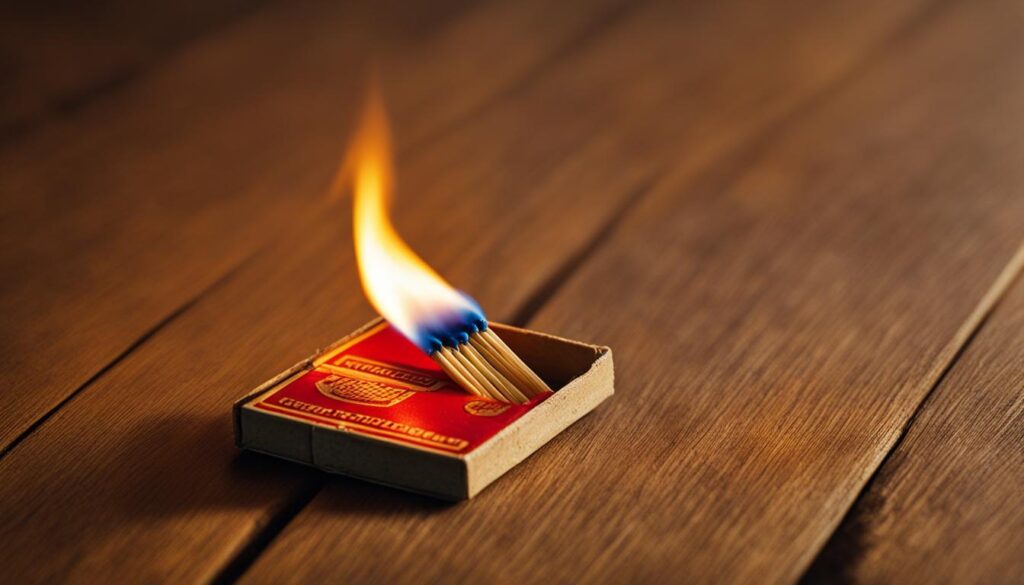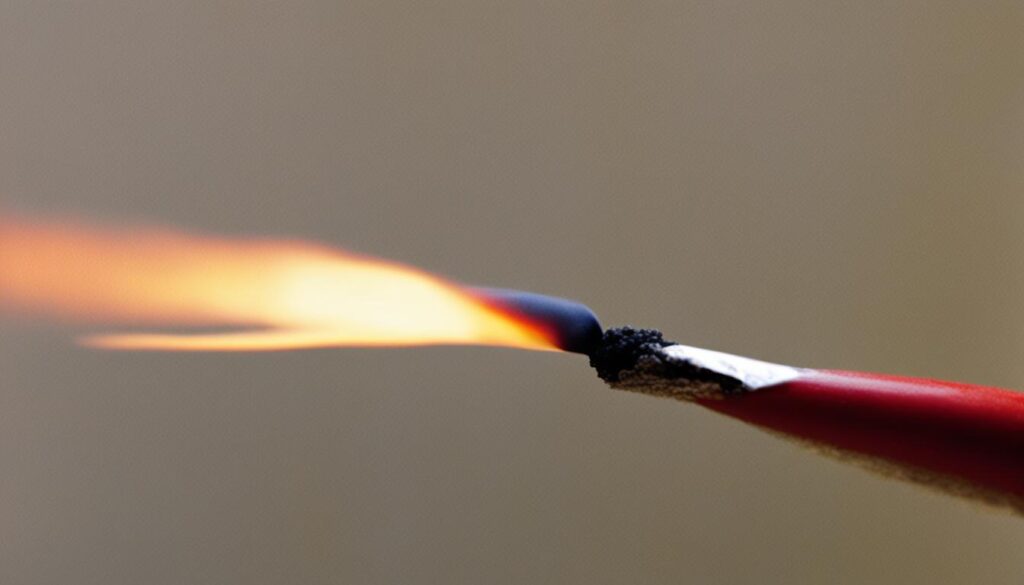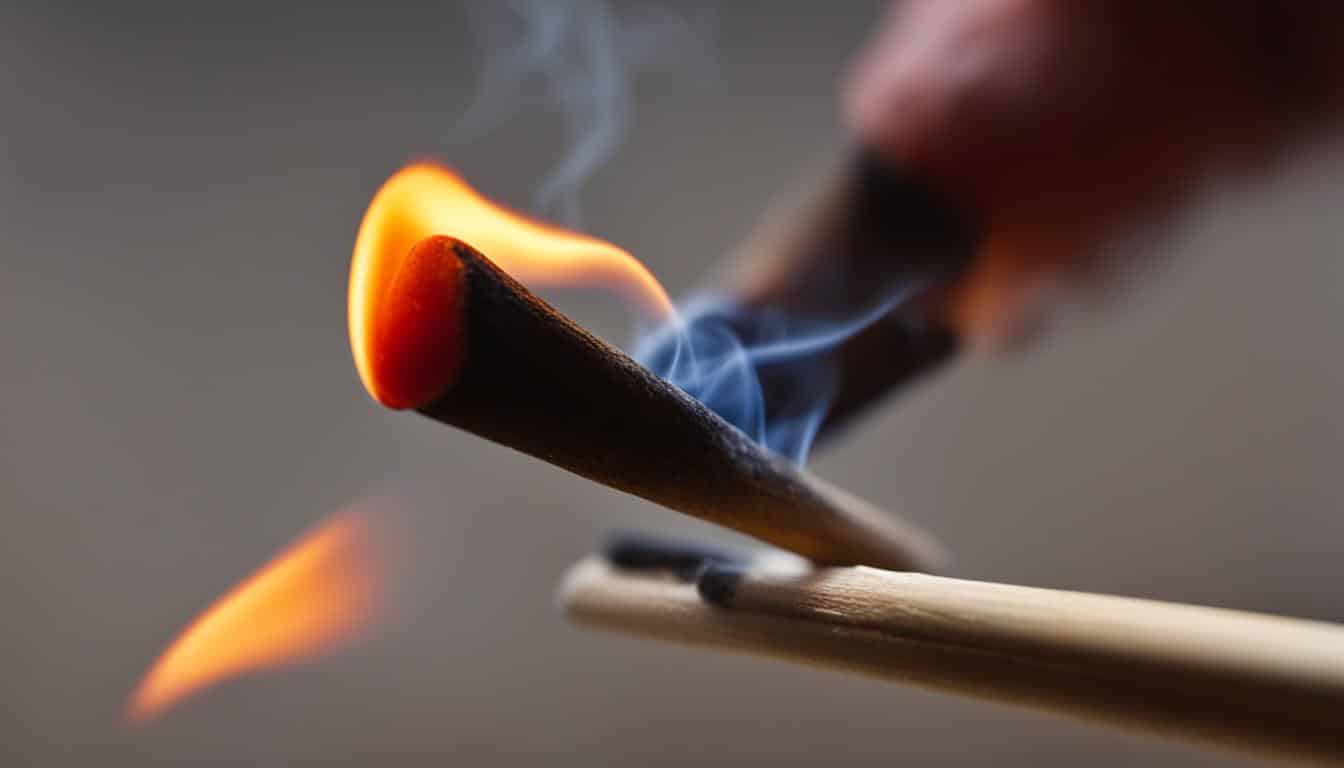As a curious individual, I’ve always been fascinated by the seemingly simple, yet complex underlying science in our everyday experiences. One such experience is lighting a match. Most people might perceive it as a physical change—after all, the matchstick’s shape remains the same, and only its temperature seems to change. However, upon closer examination, we find that lighting a match involves a rapid series of intricate chemical reactions leading to the manifestation of new substances such as carbon dioxide, water vapor, and others. So, is lighting a match a chemical change? The short answer is: yes!
Key Takeaways
- Chemical change occurrence: Lighting a match is indeed a chemical change, not just a physical one, as new substances are formed.
- Ingredients’ roles: Chemicals like antimony trisulphide, potassium chlorate, and red phosphorus transform during the ignition process, resulting in heat, light, and other compounds.
- Chemical reaction definition: A process in which substances transform into new substances with different chemical bonds, as exhibited in match lighting.
- Visual signs: The appearance of flame, heat, and other byproducts demonstrates a chemical change when striking a match.
- Energy transformation: In lighting a match, chemical potential energy stored within the match head compounds transforms into thermal energy, emitting heat and light.
The Spark of Discovery: Understanding Chemical Reactions
Chemical reactions are processes where substances transform into new substances with different chemical bonds. One prime example of a chemical reaction is the event of lighting a match, which involves friction, fuel, and oxidizing agents that create a chain of reactions breaking chemical bonds and forming new compounds. The hallmark of chemical reactions is the release or absorption of energy in some form, typically accompanied by the appearance of new material formation, heat, and light.
Let’s explore how a seemingly simple action—lighting a match—is a chemical reaction. Through this, we can begin to understand how the match striking chemical change compares to other common chemical changes, such as metal corrosion or the browning of fruit.
- Friction: When using force to strike the match against a rough surface, the ensuing friction generates heat, igniting the chemicals in the match head.
- Fuel: A match head contains antimony trisulfide, which acts as the fuel for the chemical reaction. Once ignited by friction, antimony trisulfide reacts with the oxidizing agent, potassium chlorate, to produce a flame.
- Oxidizing Agent: In this case, potassium chlorate aids in providing oxygen to the reaction, resulting in a vigorous combustion process that sustains the flame.
The transformation of substances during this process is significant, resulting in the production of new materials such as carbon dioxide, water vapor, and more. Because new substances are formed, the chemical reaction of lighting a match unequivocally leads to a chemical change. This is similar to the formation of rust on iron or the development of brown spots on a fruit’s skin, both of which are indicative of new substances being created due to chemical reactions.
“A chemical reaction is a process where substances change into new substances with different chemical bonds.”
To sum up, observing a match ignite serves as an excellent starting point for understanding chemical reactions. By examining the is match striking a chemical reaction question, we can see how a simple, everyday action consists of complex processes involving friction, fuel, and oxidizing agents, eventually leading to the creation of new substances and the release or absorption of energy.
The Composition of a Match: Ingredients for Combustion
The match head’s ingredients each play a crucial role in the combustion process. Antimony trisulphide acts as the fuel needed for sustained burning, providing a reaction that yields energy in the form of a flame. Potassium chlorate is an essential oxidizer facilitating ample oxygen to fuel the reaction intensively and transforming the heat from friction into a direct fire source. Paraffin wax coats the matchstick to ensure a controlled burn down to the wood.

How the Match Head Ingredients Contribute to the Reaction
Red phosphorus, when struck against the matchbox’s friction surface, undergoes a heat-induced transformation into white phosphorus. This reaction is exceedingly volatile, marking the initial ignition of the match head. The exothermic character of this reaction stands as the starting point for the subsequent series of reactions throughout the match head.
Function of Phosphorus in Match Lighting
Phosphorus plays a pivotal role in the match lighting chemical reaction. When friction generates enough heat, red phosphorus transforms into white phosphorus, which is highly reactive. This ignites the match head and initiates a series of chemical changes that result in the sustained flame of a lit match.
The Role of Potassium Chlorate in Oxidation
Potassium chlorate’s role in match head composition is significant in the chemical change of striking a match. It serves as an oxidizer, supplying oxygen to the reaction and enabling the match to burn easily. This allows the flame to consume the fuel efficiently and ensures the match remains useful as an ignition source for a sufficient duration. The oxidizing process plays a key role in the match striking chemical change.
“The ignition of a match head signifies a chemical change where the composition of substances is altered through a series of complex reactions.”
The role of each ingredient in a match head showcases the precise balance of chemical components required to create a controlled, efficient flame. From the fuel source to oxidizers and other stabilizing elements, their coordinated interactions demonstrate how striking a match is, in fact, a chemical change.
Striking Evidence: Visual Signs of a Chemical Change
When we strike a match, several visual clues point to the occurrence of a chemical reaction, indicating that match striking is undoubtedly a chemical change. These signs provide a fascinating glimpse into the chemistry at work during the ignition process and highlight the transformation from solid match head to gaseous combustion products.
- Instant flame: The sudden appearance of a flame upon striking the match is the first sign that a chemical change is taking place. This explosive moment indicates that heat generated by friction is acting on the chemicals in the match head, igniting a swift and energetic reaction.
- Temperature change: The drastic shift from the warmth of friction to the intense heat of a burning flame further highlights that a chemical reaction is occurring. This stark contrast in temperature showcases the combusting chemical ingredients and their rapid transformation.
- Change of state: As the match burns, the solid match head converts into gaseous combustion products, signaling a chemical change. This conversion leaves behind unmistakable evidence, such as ash and the scent of burnt chemicals, that a chemical reaction has taken place.
These visual signs prove that match striking is a chemical reaction rather than a mere physical change. Through a captivating display of flame and heat, a match’s striking moment reveals the powerful chemistry at play in this seemingly simple action.
“The abrupt appearance of flame and change from mere warmth to significant heat indicates the process of combusting chemical ingredients. The transformation from solid match head to gaseous combustion products, along with the scent of burnt chemicals, are unmistakable signs of a chemical reaction taking place.”
By examining these indicators closely, we can appreciate the fascinating and complex nature of chemical reactions occurring when a match is struck, better understanding the intricacies of this everyday phenomenon and its potential real-world applications.
The Heat Factor: Energy Transformation in Chemical Reactions
Chemical reactions often involve energy transformations, which play a vital role in unleashing the full potential of the process. One such everyday example is the act of lighting a match. So, is lighting a match a chemical change? Absolutely! The energy required to ignite the match comes from the frictional heat generated when the match is struck, which then triggers the chemical reactions in the match head.

As the match burns, chemical potential energy stored in the match head compounds is transformed into thermal energy, emitting light and heat. This exothermic reaction, showcasing the conversion of chemical energy into other forms, is one of the key criteria to classify this process as a match lighting chemical change. In the following table, you can see the summarized process of energy transformation in a match lighting.
| Stage | Energy Source | Energy Type | Outcome |
|---|---|---|---|
| 1. Striking Match | Friction between match and strike surface | Mechanical energy | Heating up red phosphorus |
| 2. Initial Ignition | After red phosphorus turns into white phosphorus | Chemical potential energy | Match head ignites in a highly reactive burst |
| 3. Burning | Combustion of match head materials | Exothermic chemical reactions | Production of flame and heat |
| 4. Extinguishing | Insufficient oxygen or fuel source | Natural equilibrium after end of chemical reaction | Match flame extinguishes and end of energy transformation |
The process of lighting a match is not only a fascinating example of energy transformation in action but also serves as a powerful tool to better understand and appreciate the complex interconnectedness of chemical reactions in our daily lives.
Anatomy of a Match Flame: Color and Substance
Examining the color and byproducts of a match flame provides valuable insights into the match lighting chemical change and chemical reaction of lighting a match. The flame’s color varies, indicating different temperatures and reactions at various points. Additionally, the byproducts produced during a match ignition serve as tangible proof of a chemical change taking place.
Deciphering the Flame Color During Match Combustion
The color of a match flame can range from blue at the base to a brighter yellow or orange at the tip. The blue region, where complete combustion occurs, results in a higher temperature, while the yellow portion is due to the partial combustion of vaporized carbon atoms that glow when heated up. This color variation indicates is lighting a match a chemical change, as it signifies the various chemical reactions within the flame.
Identifying the Byproducts of a Match Ignition
When a match is ignited, several byproducts are formed, including:
- Carbon dioxide
- Water vapor
- Unburnt particles contributing to smoke
These byproducts offer tangible evidence of the match lighting chemical reaction, as the substances within the match head transform into new compounds. Understanding these byproducts helps to further elucidate the question: is lighting a match a chemical change?
Comparing Chemical and Physical Changes: The Case of a Glowing Match
Understanding the difference between chemical and physical changes is essential to grasp the science behind everyday phenomena. In the context of lighting a match, it’s easy to see why some may assume it’s merely a physical change. However, is striking a match a chemical change? Let’s explore the evidence that shows how match striking involves chemical changes instead of purely physical alterations.
Physical changes involve alterations in the form or appearance of a substance without changing its chemical composition. Conversely, chemical changes result in the formation of entirely new substances with different chemical properties.
When a match is struck, several telltale signs indicate that it undergoes a chemical change:
- Heat and light are produced, signifying a release of energy.
- New substances, such as carbon dioxide and water vapor, are formed.
- The distinct smell of burnt chemicals is noticeable.
- The match head’s chemical structure and composition are altered.
| Characteristic | Physical Change | Chemical Change |
|---|---|---|
| Alters chemical structure or composition | No | Yes |
| Produces new substances | No | Yes |
| Accompanied by energy release or absorption (heat, light, etc.) | Usually not | Yes |
| Easily reversible | Yes | No |
As the table illustrates, a match lighting exhibits characteristics consistent with chemical changes, highlighting the distinction between chemical and physical transformations. In this case, the match striking chemical change creates a striking contrast to physical changes often seen in other everyday occurrences, such as freezing water, melting ice, or even breaking a pencil.
Ultimately, understanding the intricate chemical reactions behind match striking chemical changes sheds light on the complex nature of chemistry. And while physical changes are essential in their own right, the world of chemical changes brings forth fascinating reactions and transformations, as clearly displayed during the simple act of lighting a matchstick.

The Chemistry Behind Match Safety Features
While the process of lighting a match is undoubtedly fascinating, what’s truly remarkable is the thoughtful chemical design behind match safety features. From minimizing excessive smoking to promoting controlled burning, safety measures are meticulously built into the very composition of the match.
Ingredients that Prevent Excessive Smoking and Ensure Controlled Burning
Ammonium phosphate is an essential ingredient in match head compositions. It plays a critical role in reducing excessive smoking when a match is extinguished. The presence of this substance demonstrates the awareness and emphasis on user safety when creating matches.
In addition to ammonium phosphate, paraffin wax is another crucial component responsible for improving safety when lighting a match. Coating the matchstick, paraffin wax guarantees a controlled burn. This feature lowers the risk of accidents and ensures a practical and reliable match-lighting experience.
Matches incorporate substances like ammonium phosphate to minimize excessive smoking when the match is extinguished, indicating a thoughtful chemical design for safety.
Understanding the match lighting chemical reaction and its safety features can provide a clearer perspective on the is match striking a chemical reaction debate. The deliberate inclusion of these ingredients in the match’s composition highlights the importance of user safety and showcases the practical application of chemical knowledge in designing an everyday tool.
Real-World Applications: Learning from the Chemistry of Matches
The chemical change of lighting a match goes beyond a simple act of ignition and serves as an effective tool for understanding chemical reactions and energy transformations. Matches illustrate applied chemical principles that have practical educational value and offer insights into essential concepts like safety precautions and the physics of controlled burning.

Matches exemplify the importance of chemical reactions in daily life and can be used as a platform to teach these concepts:
- Energy transformations: Matches demonstrate the conversion of chemical potential energy into heat and light through an exothermic process.
- Reaction rates: The rapid ignition and controlled burn of a match reveal the factors that influence reaction rates, such as reactants’ concentrations, temperature, and surface area.
- Fire safety: The design and composition of a match show the application of chemistry in safety protocols, enabling a controlled and manageable flame that minimizes hazards.
Let us explore the real-world applications of the match lighting chemical change further:
| Application | Description |
|---|---|
| Education and training | Matches provide an engaging and accessible introduction into chemical reactions and fire safety in both educational and professional settings. |
| Emergency preparedness | Understanding the chemistry of matches can inform emergency response teams and firefighters on how to handle fires and other chemical reactions effectively. |
| Consumer products | Insights into match chemistry have led to improved safety features in commercially produced matches and similar ignition devices, resulting in safer consumer experiences. |
| Scientific research | Studying matches can inspire innovations in combustion technology and new discoveries in the field of energy transformation and reaction engineering. |
In conclusion, the simple yet powerful chemical transformation involved in a match lighting serves as an invaluable educational and practical tool in understanding chemical reactions. From influencing fire safety measures to inspiring scientific advancements, matches will continue to ignite awe and wonder in the minds of learners and researchers alike.
Unraveling the Mystery of the Matchstick
Is lighting a match a chemical change? Absolutely! A striking display of chemical reactions culminates in the ignition of a match, resulting in new substances being formed and energy being released. The precise blend of ingredients in the match head, including fuel, oxidizers, and safety additives, pave the way for an exothermic reaction driven by friction-generated heat.
Decoding the chemical reaction of lighting a match helps us understand the fascinating world of chemistry that lies at our fingertips. New compounds, such as carbon dioxide and water vapor, accompany byproducts like smoke and soot as evidence of the chemical transformation. From the spectacular eruption of flame to the trace of smoke left behind, a lit match demonstrates the complex interplay of elements that result in a controlled yet powerful burn.
There is much we can learn from the seemingly ordinary act of lighting a match. Studying the match lighting chemical change reinforces our understanding of energy transformations and chemical reactions that can be applied to countless real-world scenarios. So, the next time you strike a match, take a moment to marvel at the intricate science at work, and appreciate the chemical wonders that unfold right before your eyes.
FAQ
Is lighting a match a chemical change?
Yes, lighting a match is a chemical change. The process involves a series of complex chemical reactions that transform the substances within the match head into new compounds, releasing heat and light in the process.
What are the main chemical reactions that occur when lighting a match?
The primary chemical reactions that occur when a match is lit include the conversion of red phosphorus into white phosphorus, the combustion of antimony trisulphide (the fuel), and the oxidation facilitated by potassium chlorate (the oxidizer). These reactions ultimately produce new substances, such as carbon dioxide and water vapor.
How does friction play a role in igniting a match?
Friction generates heat when the match is struck against the matchbox’s rough surface, converting the red phosphorus on the stripe into highly reactive white phosphorus. This ignition causes the other compounds in the match head to react, leading to a sustained flame.
What are the visual signs of a chemical change when a match is lit?
The visual signs of a chemical change when lighting a match include the sudden appearance of a flame, a change from warmth to significant heat, and the transformation of the solid match head into gaseous combustion products. The scent of burnt chemicals also suggests a chemical reaction taking place.
How does the color of the match flame signify different reactions and temperatures?
The color of a match flame can range from blue at the base to a brighter yellow or orange at the tip, indicating different temperatures and reactions. The blue region corresponds to complete combustion and higher temperatures, while the yellow portion is due to the partial combustion of vaporized carbon atoms, which produce a yellow glow as they heat up.
What are some safety features in the chemistry of matches?
Matches incorporate substances like ammonium phosphate to minimize excessive smoking when the match is extinguished. Paraffin wax coating on the matchstick ensures a controlled burn, while ingredients in the match head are designed to prevent accidents and improve user safety when lighting a match.
How is the lighting of a match an example of real-world application of chemical principles?
The chemistry behind lighting a match demonstrates applied chemical principles, such as understanding chemical reactions and energy transformations. Matches serve as an everyday example of how chemical concepts can be practically applied beyond their use as a simple ignition tool.

